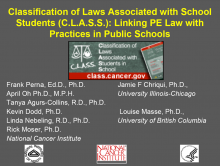We are pleased to announce an exciting new alliance between Active Living Research and GP RED to co-host and coordinate...
Classification of Laws Associated with School Students (CLASS): Linking PE Law with PE Practices in Public Schools

Presentation at the 2011 Active Living Research Annual Conference
Background:
State-level school physical education and nutrition laws are a potential mechanism to curb childhood obesity. C.L.A.S.S. (Classification of Laws Associated with School Students) is a scoring system that monitors and evaluates state-level school physical education (PE) and nutrition policies, by school level, that have been codified into law.
Objectives:
This presentation demonstrates how C.L.A.S.S.’s Physical Education-Related State Policy Classification System (PERSPCS) data can be merged with school-level data to examine the extent to which State laws were associated with minutes PE and with meeting national recommendations for weekly PE as assessed by the School Health Policies and Programs Survey (SHPPS).
Methods:
PERSPCS Time Requirement Groups. PERSPCS codes for each state were used to group schools in the SHPPS to form 3 distinct groups: schools within states with either No PE requirement; PE-required/ time-unspecified, or PE-required/time-specified.
PE-Min/Week. For each grade, the SHHPS School survey assessed: “How many weeks during the school year are ___graders scheduled to take PE? On average, how many days per week are ___graders scheduled to take PE? On average, how many minutes is each session of PE scheduled to last?” Time for PE in each grade was calculated to standardize PE-time for each grade according to a 36-week school year. PE-Min/week for each grade was averaged according school level (elementary, middle, or high) to yield the school’s average PE-Min/week.PE-Min/Week was examined as a continuous variable and as dichotomous outcome (met/did-not-meet recommendation).
NASPE Standard. The continuous measure PE-Min/week for each school was dichotomously coded to reflect whether the school met or did not meet the National Association for Sport and Physical Education (NASPE) standard for the school’s level (i.e., 150min/week for elementary schools and 225min/week for middle and high schools) or a less stringent standard (150 min/week).
Covariates. Covariates were obtained from the SHPPS data file that included coding for each school’s size (small or large), poverty rate (low or high), and degree of urbanicity (rural or urban).
Data Analyses. As a first step, we assessed characteristics of schools included in our analyses and differences from the obtained SHPPS sample. Of the 998 SHPPS schools, 723 were public schools representing 42 states of which 313 did not provide data to derive minutes of weekly PE time, which left a final sample of 410 schools (ES n =145; MS n =131; HS n = 134) included in the analyses. While sample weights for each school were provided by CDC (http://www.cdc.gov/healthyyouth/shpps/2006/data), these weights were based on a full sample and do not account for response bias among schools that did not provide information on minutes of PE. We re-weighted to account for response bias at each school level so that ensuing analyses with sampled schools would be appropriately weighted and nationally representative.
The SAS Proc GENMOD procedure, which accounted for weighted sampling and state clustering of data, determined if PE-Min/Week differed by PERSPCS Group after accounting for demographic covariates. Separate analyses were conducted by school level, data were transformed as necessary to account for departures from normality, and multiple comparison post-hoc testing determined differences between PERSPCS Groups. Due to the lack of schools meeting NASPE recommendations for PE, logistic regression determining if PERSPCS Group differed in meeting/not-meeting national recommendation could only be conducted at the Middle school level.
Results:
At the Elementary and Middle school levels only, schools within states with laws requiring specific time requirements for PE had significantly more PE-Time than either schools within states with no PE-requirement or schools within states that had non-specific PE time requirements (p’s < .05). Schools in the latter two groups were not significantly different from each other. Specifically, Elementary and Middle schools within states with laws requiring specific time requirements for PE had significantly more PE-Time (104.8 and 208.7 min/week, respectively) than either schools within states with no PE-requirement (64.6 and 149.5 min/week) or schools within states that had non-specific PE time requirements (78.1 and148.1 min/week, respectively), p’s < .05). Urbanicity (non-urban) and Poverty (high) were covariates associated with more PE min/week at the Elementary and Middle school levels, respectively.
Meeting a NASPE recommendation for PE appeared more likely among Middle schools within states that had specific PE-Time requirements (48.3%) than at schools that had no PE-Time requirement or had a non-specific requirement (14.7%), but the difference was not statistically significant. Using a less stringent standard (150 min/week), more Middle schools within states that had specific PE-Time requirements (75.9%) than either schools that had no PE-Time requirement or had a non-specific requirement (35.2%), p < .05.
Conclusions:
Results show that codified state law was associated with actual PE time in schools. Data further suggest that increased PE was only associated with state policy when laws both required and specified PE-time allotment.
Support:
National Cancer Institute
STAY UP TO DATE
RECENTLY ADDED TOOLS & RESOURCES
MOVE! A BLOG ABOUT ACTIVE LIVING
The "Active Living Conference" aims to break down research and practice silos and...







